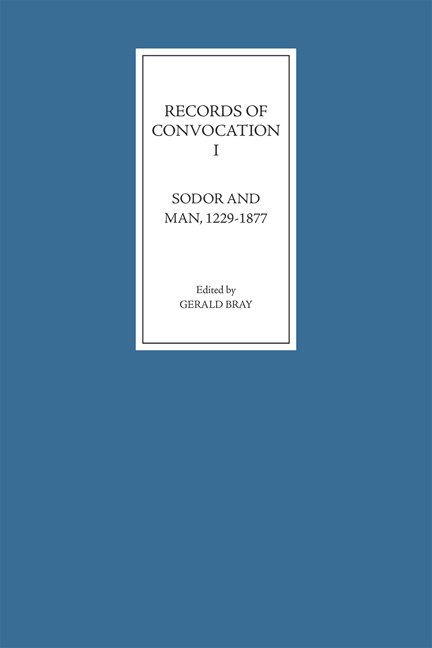Book contents
- Frontmatter
- Content
- Editor's Note
- Introduction
- Pre-Reformation Statutes
- The Book of Spiritual Laws and Customs, 1577
- Spiritual Ordinances of 1594
- The Customary Laws Of 1598
- Early Seventeenth-Century Convocations
- Spiritual Ordinances and Customary Laws, 1643
- The Injunction of 1658
- The Instructions of Bishop Barrow, 1663
- The Accustomed Unwritten Ecclesiastical Laws, 1667
- The Convocations Of 1680
- The Convocation Of 26 July 1683
- The Convocation Of 17 August 1685
- The Proclamation of Bishop Levinz, 1690
- The Act Against Non-Residence, 1696
- The Convocation of 3 February 1704
- The Convocations Of Bishop Thomas Wilson, 1704-54
- Bishop Mark Hildesley (1755-72)
- Bishop Richard Richmond (1773-80)
- Bishop George Mason (1780-3)
- Bishop Claudius Crigan (1784-1813)
- Bishop George Murray (1814-27)
- Bishop William Ward (1828-38)
- Bishop James Bowstead (1838-40)
- Bishop Henry Pepys (1840-1)
- Bishop Thomas Vowler Short (1841-6)
- Bishop Walter Augustus Shirley (1846-7)
- Bishop Robert John Eden (1847-54)
- Bishop Horatio Powys (1854-77)
- Bishop Wilson's Parochial Libraries
- Bishops in the Isle of Man
- Lords of Man
- Governors and Lieutenant-Governors of the Isle of Man
- The Parishes and Chaplaincies of the Isle of Man
- Chronological List of the Clergy by Parishes
- Index of the Clergy (Alphabetical)
- Bibliography
- Index of References to Holy Scripture
- Index of Persons and Places
- Index Of Subjects
- Frontmatter
- Content
- Editor's Note
- Introduction
- Pre-Reformation Statutes
- The Book of Spiritual Laws and Customs, 1577
- Spiritual Ordinances of 1594
- The Customary Laws Of 1598
- Early Seventeenth-Century Convocations
- Spiritual Ordinances and Customary Laws, 1643
- The Injunction of 1658
- The Instructions of Bishop Barrow, 1663
- The Accustomed Unwritten Ecclesiastical Laws, 1667
- The Convocations Of 1680
- The Convocation Of 26 July 1683
- The Convocation Of 17 August 1685
- The Proclamation of Bishop Levinz, 1690
- The Act Against Non-Residence, 1696
- The Convocation of 3 February 1704
- The Convocations Of Bishop Thomas Wilson, 1704-54
- Bishop Mark Hildesley (1755-72)
- Bishop Richard Richmond (1773-80)
- Bishop George Mason (1780-3)
- Bishop Claudius Crigan (1784-1813)
- Bishop George Murray (1814-27)
- Bishop William Ward (1828-38)
- Bishop James Bowstead (1838-40)
- Bishop Henry Pepys (1840-1)
- Bishop Thomas Vowler Short (1841-6)
- Bishop Walter Augustus Shirley (1846-7)
- Bishop Robert John Eden (1847-54)
- Bishop Horatio Powys (1854-77)
- Bishop Wilson's Parochial Libraries
- Bishops in the Isle of Man
- Lords of Man
- Governors and Lieutenant-Governors of the Isle of Man
- The Parishes and Chaplaincies of the Isle of Man
- Chronological List of the Clergy by Parishes
- Index of the Clergy (Alphabetical)
- Bibliography
- Index of References to Holy Scripture
- Index of Persons and Places
- Index Of Subjects
Summary
The Isle of Man and its church1
A teardrop-shaped landmass of 572 square kilometres, the Isle of Man is the only place in the British Isles from which it is possible to see England, Scotland, Ireland and Wales all at the same time. Its history is not unnaturally bound up with that of these neighbours, but what is surprising about it is the extent to which it has escaped falling under the overwhelming influence of any one of them. For the Isle of Man is sui generis, not a part of the United Kingdom which surrounds it, but retaining laws and forms of government unknown or else long forgotten elsewhere in these islands.
Its recorded history begins in the high middle ages, when it was an Irishspeaking Christian island under Norse rule. Archaeological evidence, and the names of the parish churches, suggest that Christianity reached Man from Ireland, though when, or in what circumstances, no-one can now say for certain. The first Manx bishops of whom we have any knowledge were suffragans of York, appointed in the eleventh century, though this link may owe as much to Viking influence in both places as to anything else. Certainly York's medieval relationship with the Isle of Man was ephemeral, and no more was heard of it after about 1100.
The Vikings arrived in Man sometime in the ninth century and after a fairly slow conquest, they managed to establish a kingdom there which was ultimately dependent on Norway. By 1100 the kings of Man were recognized as rulers of the Scottish Hebrides, and occasionally of the Mull of Kintyre also. These Scottish possessions were known to the Norsemen as the sudre oyar (southern islands) - 'southern’ in relation to Orkney and Shetland that is - and it is from this that the name Sodor is derived. In 1134 King Olaf I (1103-53) established a bishopric in his kingdom which in 1153 became part of the ecclesiastical province of Nidaros (Trondheim) in Norway.2
This seems to have been the final stage in a governmental organization which encompassed every aspect of Manx life. The Norsemen divided the Isle of Man into a north and a south side, apparently because of perceived ethnic distinctions between them. The north side was where the Viking settlements mainly were, whereas the south side seems to have remained more purely Gaelic.
- Type
- Chapter
- Information
- Records of Convocation , pp. 1 - 22Publisher: Boydell & BrewerFirst published in: 2024

